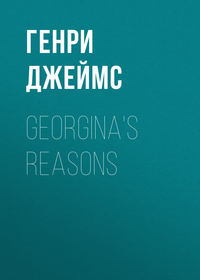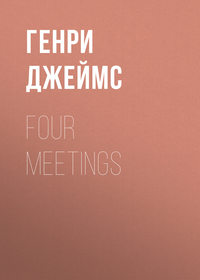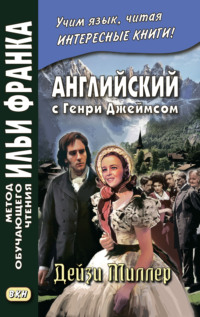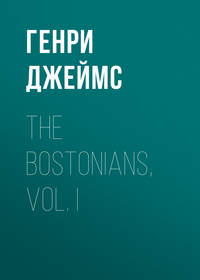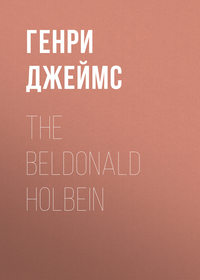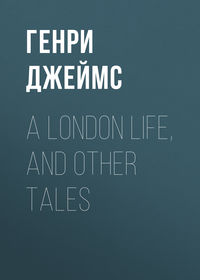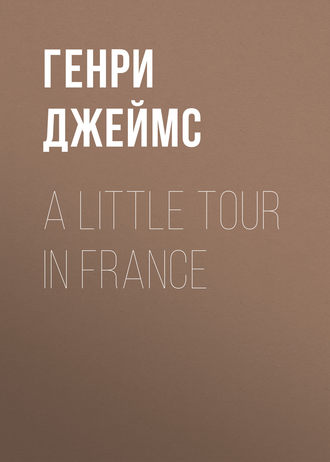 полная версия
полная версияA Little Tour in France
I was obliged to cultivate relations with the cuisine of this establishment. Nothing could have been more meridional; indeed, both the dirty little inn and Nar- bonne at large seemed to me to have the infirmities of the south, without its usual graces. Narrow, noisy, shabby, belittered and encumbered, filled with clatter and chatter, the Hotel de France would have been described in perfection by Alphonse Daudet. For what struck me above all in it was the note of the Midi, as he has represented it, – the sound of universal talk. The landlord sat at supper with sundry friends, in a kind of glass cage, with a genial indifference to arriv- ing guests; the waiters tumbled over the loose luggage in the hall; the travellers who had been turned away leaned gloomily against door-posts; and the landlady, surrounded by confusion, unconscious of responsibility, and animated only by the spirit of conversation, bandied high-voiced compliments with the voyageurs de com- merce. At ten o'clock in the morning there was a table d'hote for breakfast, – a wonderful repast, which overflowed into every room and pervaded the whole establishment. I sat down with a hundred hungry marketers, fat, brown, greasy men, with a good deal of the rich soil of Languedoc adhering to their hands and their boots. I mention the latter articles because they almost put them on the table. It was very hot, and there were swarms of flies; the viands had the strongest odor; there was in particular a horrible mix- ture known as gras-double, a light gray, glutinous, nauseating mess, which my companions devoured in large quantities. A man opposite to me had the dir- tiest fingers I ever saw; a collection of fingers which in England would have excluded him from a farmers' ordinary. The conversation was mainly bucolic; though a part of it, I remember, at the table at which I sat, consisted of a discussion as to whether or no the maid- servant were sage, – a discussion which went on under the nose of this young lady, as she carried about the dreadful gras-double, and to which she contributed the most convincing blushes. It was thoroughly meri- dional.
In going to Narbonne I had of course counted upon Roman remains; but when I went forth in search of them I perceived that I had hoped too fondly. There is really nothing in the place to speak of; that is, on the day of my visit there was nothing but the market, which was in complete possession. "This intricate, curious, but lifeless town," Murray calls it; yet to me it appeared overflowing with life. Its streets are mere crooked, dirty lanes, bordered with perfectly insignifi- cant houses; but they were filled with the same clatter and chatter that I had found at the hotel. The market was held partly in the little square of the hotel de ville, a structure which a flattering wood-cut in the Guide-Joanne had given me a desire to behold. The reality was not impressive, the old color of the front having been completely restored away. Such interest as it superficially possesses it derives from a fine mediaeval tower which rises beside it, with turrets at the angles, – always a picturesque thing. The rest of the market was held in another place, still shabbier than the first, which lies beyond the canal. The Canal du Midi flows through the town, and, spanned at this point by a small suspension-bridge, presented a cer- tain sketchability. On the further side were the venders and chafferers, – old women under awnings and big um- brellas, rickety tables piled high with fruit, white caps and brown faces, blouses, sabots, donkeys. Beneath this picture was another, – a long row of washerwomen, on their knees on the edge of the canal, pounding and wringing the dirty linen of Narbonne, – no great quantity, to judge by the costume of the people. In- numerable rusty men, scattered all over the place, were buying and selling wine, straddling about in pairs, in groups, with their hands in their pockets, and packed together at the doors of the cafes. They were mostly fat and brown and unshaven; they ground their teeth as they talked; they were very meridionaux.
The only two lions at Narbonne are the cathedral and the museum, the latter of which is quartered in the hotel de ville. The cathedral, closely shut in by houses, and with the west front undergoing repairs, is singular in two respects. It consists exclusively of a choir, which is of the end of the thirteenth century and the beginning of the next, and of great magnifi- cence. There is absolutely nothing else. This choir, of extraordinary elevation, forms the whole church. I sat there a good while; there was no other visitor. I had taken a great dislike to poor little Narbonne, which struck me as sordid and overheated, and this place seemed to extend to me, as in the Middle Ages, the privilege of sanctuary. It is a very solemn corner. The other peculiarity of the cathedral is that, exter- nally, it bristles with battlements, having anciently formed part of the defences of the archeveche, which is beside it and which connects it with the hotel de ville. This combination of the church and the for- tress is very curious, and during the Middle Ages was not without its value. The palace of the former arch- bishops of Narbonne (the hotel de ville of to-day forms part of it) was both an asylum and an arsenal during the hideous wars by which the Languedoc was ravaged in the thirteenth century. The whole mass of buildings is jammed together in a manner that from certain points of view makes it far from apparent which feature is which. The museum occupies several chambers at the top of the hotel de ville, and is not an imposing collection. It was closed, but I induced the portress to let me in, – a silent, cadaverous person, in a black coif, like a beguine, who sat knitting in one of the windows while I went the rounds. The number of Roman fragments is small, and their quality is not the finest; I must add that this impression was hastily gathered. There is indeed a work of art in one of the rooms which creates a presumption in favor of the place, – the portrait (rather a good one) of a citizen of Narbonne, whose name I forget, who is described as having devoted all his time and his intelligence to collecting the objects by which the. visitor is sur- rounded. This excellent man was a connoisseur, and the visitor is doubtless often an ignoramus.
XXV
"Cette, with its glistening houses white,Curves with the curving beach awayTo where the lighthouse beacons bright,Far in the bay."That stanza of Matthew Arnold's, which I hap- pened to remember, gave a certain importance to the half-hour I spent in the buffet of the station at Cette while I waited for the train to Montpellier. I had left Narbonne in the afternoon, and by the time I reached Cette the darkness had descended. I therefore missed the sight of the glistening houses, and had to console myself with that of the beacon in the bay, as well as with a bouillon of which I partook at the buffet afore- said; for, since the morning, I had not ventured to return to the table d'hote at Narbonne. The Hotel Nevet, at Montpellier, which I reached an hour later, has an ancient renown all over the south of France, – advertises itself, I believe, as le plus vaste du midi. It seemed to me the model of a good provincial inn; a big rambling, creaking establishment, with brown, labyrinthine corridors, a queer old open-air vestibule, into which the diligence, in the bon temps, used to penetrate, and an hospitality more expressive than that of the new caravansaries. It dates from the days when Montpellier was still accounted a fine winter re- sidence for people with weak lungs; and this rather melancholy tradition, together with the former celebrity of the school of medicine still existing there, but from which the glory has departed, helps to account for its combination of high antiquity and vast proportions. The old hotels were usually more concentrated; but the school of medicine passed for one of the attrac- tions of Montpellier. Long before Mentone was dis- covered or Colorado invented, British invalids travelled down through France in the post-chaise or the public coach to spend their winters in the wonderful place which boasted both a climate and a faculty. The air is mild, no doubt, but there are refinements of mild- ness which were not then suspected, and which in a more analytic age have carried the annual wave far beyond Montpellier. The place is charming, all the same; and it served the purpose of John Locke; who made a long stay there, between 1675 and 1679, and became acquainted with a noble fellow-visitor, Lord Pembroke, to whom he dedicated the famous Essay. There are places that please, without your being able to say wherefore, and Montpellier is one of the num- ber. It has some charming views, from the great pro- menade of the Peyrou; but its position is not strikingly fair. Beyond this it contains a good museum and the long facades of its school, but these are its only de- finite treasures. Its cathedral struck me as quite the weakest I had seen, and I remember no other monu- ment that made up for it. The place has neither the gayety of a modern nor the solemnity of an ancient town, and it is agreeable as certain women are agree- able who are neither beautiful nor clever. An Italian would remark that it is sympathetic; a German would admit that it is gemuthlich. I spent two days there, mostly in the rain, and even under these circum- stances I carried away a kindly impression. I think the Hotel Nevet had something to do with it, and the sentiment of relief with which, in a quiet, even a luxurious, room that looked out on a garden, I reflected that I had washed my hands of Narbonne. The phyl- loxera has destroyed the vines in the country that sur- rounds Montpellier, and at that moment I was capable of rejoicing in the thought that I should not breakfast with vintners.
The gem of the place is the Musee Fabre, one of the best collections of paintings in a provincial city. Francois Fabre, a native of Montpellier, died there in 1837, after having spent a considerable part of his life in Italy, where he had collected a good many valuable pictures and some very poor ones, the latter class including several from his own hand. He was the hero of a remarkable episode, having succeeded no less a person than Vittorio Alfieri in the affections of no less a person than Louise de Stolberg, Countess of Albany, widow of no less a person than Charles Edward Stuart, the second pretender to the British crown. Surely no woman ever was associated senti- mentally with three figures more diverse, – a disqualified sovereign, an Italian dramatist, and a bad French painter. The productions of M. Fabre, who followed in the steps of David, bear the stamp of a cold me- diocrity; there is not much to be said even for the portrait of the genial countess (her life has been written by M. Saint-Rene-Taillandier, who depicts her as de- lightful), which hangs in Florence, in the gallery of the Uffizzi, and makes a pendant to a likeness of Alfieri by the same author. Stendhal, in his "Me- moires d'un Touriste," says that this work of art represents her as a cook who has pretty hands. I am delighted to have an opportunity of quoting Stendhal, whose two volumes of the "Memoires d'un Touriste" every traveller in France should carry in his port- manteau. I have had this opportunity more than once, for I have met him at Tours, at Nantes, at Bourges; and everywhere he is suggestive. But he has the de- fect that he is never pictorial, that he never by any chance makes an image, and that his style is per- versely colorless, for a man so fond of contemplation. His taste is often singularly false; it is the taste of the early years of the present century, the period that produced clocks surmounted with sentimental "sub- jects." Stendhal does not admire these clocks, but he almost does. He admires Domenichino and Guer- cino, and prizes the Bolognese school of painters be- cause they "spoke to the soul." He is a votary of the new classic, is fond of tall, squire, regular buildings, and thinks Nantes, for instance, full of the "air noble." It was a pleasure to me to reflect that five-and-forty years ago he had alighted in that city, at the very inn in which I spent a night, and which looks down on the Place Graslin and the theatre. The hotel that was the best in 1837 appears to be the best to-day. On the subject of Touraine, Stendhal is extremely refresh- ing; he finds the scenery meagre and much overrated, and proclaims his opinion with perfect frankness. He does, however, scant justice to the banks of the Loire; his want of appreciation of the picturesque – want of the sketcher's sense – causes him to miss half the charm of a landscape which is nothing if not "quiet," as a painter would say, and of which the felicities reveal themselves only to waiting eyes. He even despises the Indre, the river of Madame Sand. The "Memoires d'un Touriste" are written in the character of a commercial traveller, and the author has nothing to say about Chenonceaux or Chambord, or indeed about any of the chateaux of that part of France; his system being to talk only of the large towns, where he may be supposed to find a market for his goods. It was his ambition to pass for an ironmonger. But in the large towns he is usually excellent company, though as discursive as Sterne, and strangely indifferent, for a man of imagination, to those superficial aspects of things which the poor pages now before the reader are mainly an attempt to render. It is his conviction that Alfieri, at Florence, bored the Countess of Albany ter- ribly; and he adds that the famous Gallophobe died of jealousy of the little painter from Montpellier. The Countess of Albany left her property to Fabre; and I suppose some of the pieces in the museum of his native town used to hang in the sunny saloons of that fine old palace on the Arno which is still pointed out to the stranger in Florence as the residence of Alfieri.
The institution has had other benefactors, notably a certain M. Bruyas, who has enriched it with an extra- ordinary number of portraits of himself. As these, however, are by different hands, some of them dis- tinguished, we may suppose that it was less the model than the artists to whom M. Bruyas wished to give publicity. Easily first are two large specimens of David Teniers, which are incomparable for brilliancy and a glowing perfection of execution. I have a weak- ness for this singular genius, who combined the delicate with the grovelling, and I have rarely seen richer examples. Scarcely less valuable is a Gerard Dow which hangs near them, though it must rank lower as having kept less of its freshness. This Gerard Dow did me good; for a master is a master, whatever he may paint. It represents a woman paring carrots, while a boy before her exhibits a mouse-trap in which he has caught a frightened victim. The good-wife has spread a cloth on the top of a big barrel which serves her as a table, and on this brown, greasy napkin, of which the texture is wonderfully rendered, lie the raw vegetables she is preparing for domestic consumption. Beside the barrel is a large caldron lined with copper, with a rim of brass. The way these things are painted brings tears to the eyes; but they give the measure of the Musee Fabre, where two specimens of Teniers and a Gerard Dow are the jewels. The Italian pictures are of small value; but there is a work by Sir Joshua Rey- nolds, said to be the only one in France, – an infant Samuel in prayer, apparently a repetition of the pic- ture in England which inspired the little plaster im- age, disseminated in Protestant lands, that we used to admire in our childhood. Sir Joshua, somehow, was an eminently Protestant painter; no one can forget that, who in the National Gallery in London has looked at the picture in which he represents several young ladies as nymphs, voluminously draped, hanging gar- lands over a statue, – a picture suffused indefinably with the Anglican spirit, and exasperating to a mem- ber of one of the Latin races. It is an odd chance, therefore, that has led him into that part of France where Protestants have been least bien vus. This is the country of the dragonnades of Louis XIV. and of the pastors of the desert. From the garden of the Peyrou, at Montpellier, you may see the hills of the Cevennes, to which they of the religion fled for safety, and out of which they were hunted and harried.
I have only to add, in regard to the Musee Fabre, that it contains the portrait of its founder, – a little, pursy, fat-faced, elderly man, whose countenance con- tains few indications of the power that makes distin- guished victims. He is, however, just such a personage as the mind's eye sees walking on the terrace of the Peyrou of an October afternoon in the early years of the century; a plump figure in a chocolate-colored coat and a culotte that exhibits a good leg, – a culotte pro- vided with a watch-fob from which a heavy seal is suspended. This Peyrou (to come to it at last) is a wonderful place, especially to be found in a little pro- vincial city. France is certainly the country of towns that aim at completeness; more than in other lands, they contain stately features as a matter of course. We should never have ceased to hear about the Peyrou, if fortune had placed it at a Shrewsbury or a Buffalo. It is true that the place enjoys a certain celebrity at home, which it amply deserves, moreover; for nothing could be more impressive and monumental. It consists of an "elevated platform," as Murray says, – an im- mense terrace, laid out, in the highest part of the town, as a garden, and commanding in all directions a view which in clear weather must be of the finest. I strolled there in the intervals of showers, and saw only the nearer beauties, – a great pompous arch of triumph in honor of Louis XIV. (which is not, properly speaking, in the garden, but faces it, straddling across the place by which you approach it from the town), an equestrian statue of that monarch set aloft in the middle of the terrace, and a very exalted and complicated fountain, which forms a background to the picture. This foun- tain gushes from a kind of hydraulic temple, or cha- teau d'eau, to which you ascend by broad flights of steps, and which is fed by a splendid aqueduct, stretched in the most ornamental and unexpected manner across the neighboring valley. All this work dates from the middle of the last century. The com- bination of features – the triumphal arch, or gate; the wide, fair terrace, with its beautiful view; the statue of the grand monarch; the big architectural fountain, which would not surprise one at Rome, but goes sur- prise one at Montpellier; and to complete the effect, the extraordinary aqueduct, charmingly fore-shortened, – all this is worthy of a capital, of a little court-city. The whole place, with its repeated steps, its balus- trades, its massive and plentiful stone-work, is full of the air of the last century, – sent bien son dix-huitieme siecle; none the less so, I am afraid, that, as I read in my faithful Murray, after the revocation of the Edict of Nantes, the block, the stake, the wheel, had been erected here for the benefit of the desperate Camisards.
XXVI
It was a pleasure to feel one's self in Provence again, – the land where the silver-gray earth is im- pregnated with the light of the sky. To celebrate the event, as soon as I arrived at Nimes I engaged a caleche to convey me to the Pont du Gard. The day was yet young, and it was perfectly fair; it ap- peared well, for a longish drive, to take advantage, without delay, of such security. After I had left the town I became more intimate with that Provencal charm which I had already enjoyed from the window of the train, and which glowed in the sweet sunshine and the white rocks, and lurked in the smoke-puffs of the little olives. The olive-trees in Provence are half the landscape. They are neither so tall, so stout, nor so richly contorted as I have seen them beyond the Alps; but this mild colorless bloom seems the very texture of the country. The road from Nimes, for a distance of fifteen miles, is superb; broad enough for an army, and as white and firm as a dinner-table. It stretches away over undulations which suggest a kind of harmony; and in the curves it makes through the wide, free country, where there is never a hedge or a wall, and the detail is always exquisite, there is something majestic, almost processional. Some twenty minutes before I reached the little inn that marks the termination of the drive, my vehicle met with an ac- cident which just missed being serious, and which engaged the attention of a gentleman, who, followed by his groom and mounted on a strikingly handsome horse happened to ride up at the moment. This young man, who, with his good looks and charming manner, might have stepped out of a novel of Octave Feuillet, gave me some very intelligent advice in reference to one of my horses that had been injured, and was so good as to accompany me to the inn, with the re- sources of which he was acquainted, to see that his recommendations were carried out. The result of our interview was that he invited me to come and look at a small but ancient chateau in the neighborhood, which he had the happiness – not the greatest in the world, he intimated – to inhabit, and at which I en- gaged to present myself after I should have spent an hour at the Pont du Gard. For the moment, when we separated, I gave all my attention to that great structure. You are very near it before you see it; the ravine it spans suddenly opens and exhibits the picture. The scene at this point grows extremely beautiful. The ravine is the valley of the Gardon, which the road from Nimes has followed some time without taking account of it, but which, exactly at the right distance from the aqueduct, deepens and ex- pands, and puts on those characteristics which are best suited to give it effect. The gorge becomes romantic, still, and solitary, and, with its white rocks and wild shrubbery, hangs over the clear, colored river, in whose slow course there is here and there a deeper pool. Over the valley, from side to side, and ever so high in the air, stretch the three tiers of the tremendous bridge. They are unspeakably imposing, and nothing could well be more Roman. The hugeness, the soli- dity, the unexpectedness, the monumental rectitude of the whole thing leave you nothing to say – at the time – and make you stand gazing. You simply feel that it is noble and perfect, that it has the quality of greatness. A road, branching from the highway, de- scends to the level of the river and passes under one of the arches. This road has a wide margin of grass and loose stones, which slopes upward into the bank of the ravine. You may sit here as long as you please, staring up at the light, strong piers; the spot is ex- tremely natural, though two or three stone benches have been erected on it. I remained there an hour and got a cornplete impression; the place was per- fectly soundless, and for the time, at least, lonely; the splendid afternoon had begun to fade, and there was a fascination in the object I had come to see. It came to pass that at the same time I discovered in it a certain stupidity, a vague brutality. That element is rarely absent from great Roman work, which is wanting in the nice adaptation of the means to the end. The means are always exaggerated; the end is so much more than attained. The Roman rigidity was apt to overshoot the mark, and I suppose a race which could do nothing small is as defective as a race that can do nothing great. Of this Roman rigidity the Pont du Gard is an admirable example. It would be a great injustice, however, not to insist upon its beauty, – a kind of manly beauty, that of an object constructed not to please but to serve, and impressive simply from the scale on which it carries out this intention. The number of arches in each tier is dif- ferent; they are smaller and more numerous as they ascend. The preservation of the thing is extra- ordinary; nothing has crumbled or collapsed; every feature remains; and the huge blocks of stone, of a brownish-yellow, (as if they had been baked by the Provencal sun for eighteen centuries), pile themselves, without mortar or cement, as evenly as the day they were laid together. All this to carry the water of a couple of springs to a little provincial city! The con- duit on the top has retained its shape and traces of the cement with which it was lined. When the vague twilight began to gather, the lonely valley seemed to fill itself with the shadow of the Roman name, as if the mighty empire were still as erect as the supports of the aqueduct; and it was open to a solitary tourist, sitting there sentimental, to believe that no people has ever been, or will ever be, as great as that, measured, as we measure the greatness of an individual, by the push they gave to what they undertook. The Pont du Gard is one of the three or four deepest impressions they have left; it speaks of them in a manner with which they might have been satisfied.



